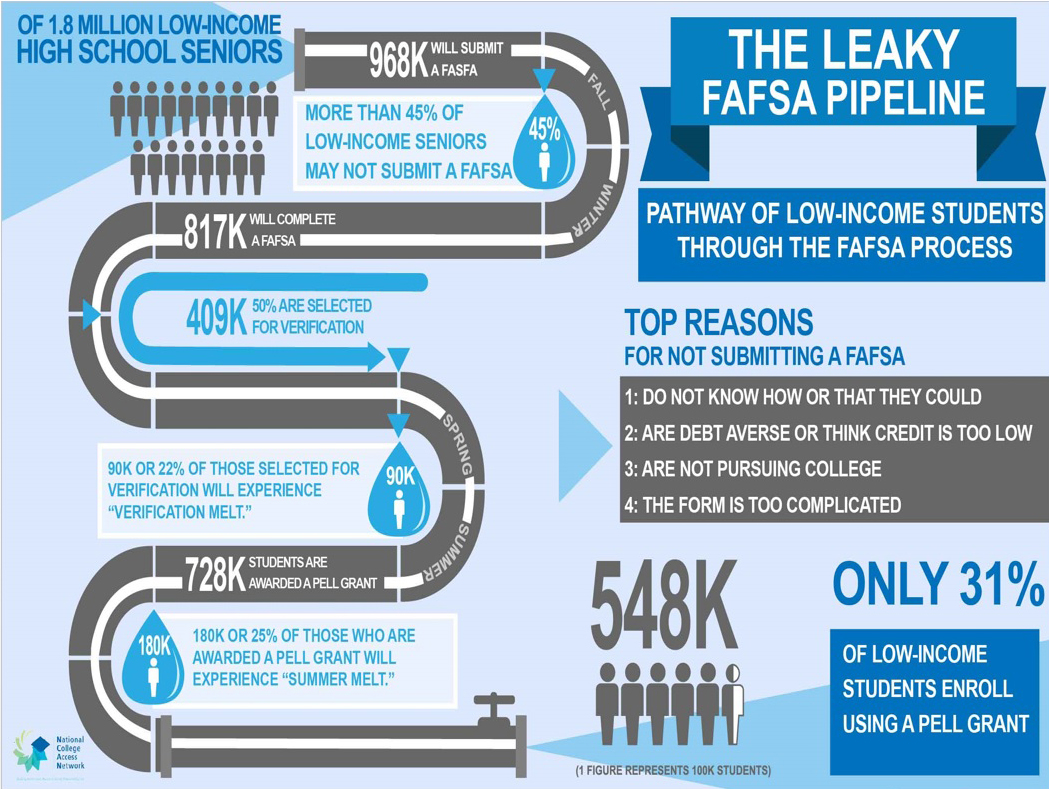 FCAN’s Amy Bolick, Community Engagement
FCAN’s Amy Bolick, Community Engagement
What is Verification?
Verification is a federal audit of submitted Free Applications for Federal Student Aid (FAFSAs). Approximately 30% of all FAFSA filers and 50% of low-income FAFSA filers are selected to provide additional documentation of the income information they report on the form.
Students will need to complete the verification process with each school they have applied to before the school will provide a financial aid award letter. The process may vary from school to
What Challenges do Students Face?
NCAN’s MorraLee Keller shared some of the challenges this process presents for selected students.
Students May Not Know They’ve Been Selected
First, because schools do not have a uniform notification procedure, many students are unaware they have been selected for verification. Students may also not realize that they must verify their income with each institution individually.
Difficulty Accessing Documents
Students may experience challenges accessing the required tax documents. Parents of dependent students must request a tax transcript from the IRS and submit copies of that transcript to each institution. Independent students, including students from foster care, must request either their own tax transcripts or a letter verifying that they did not file taxes.
Some students are dependent students according to federal guidelines, regardless of whether they receive support from or have contact with their parents. This designation can add another layer of complexity for students who are asked to submit documentation from parents who are unable or unwilling to cooperate.
Shutting Low-Income Students Out of Higher Education
Every year, only around 31% of low-income high school seniors will enroll in college the fall following graduation using a Pell Grant. While there are many factors that prevent these students from attending and accessing financial aid, verification is a significant part of the equation.
Research presented by NCAN’s Bill DeBaun demonstrates that navigating this system presents a barrier to low-income students. According to NCAN’s analysis, only 56% of low-income students selected for verification will go on to receive a Pell Grant, compared to 78% of low-income students not selected for verification. Failing to receive a Pell Grant often prevents them from enrolling the following term. This rate of “verification melt” is nearly as high as the rate of “summer melt,” when students accept admission to college in the spring but never enroll in classes in the fall.
Strategies to Assist Students with Verification
While the verification process can be challenging, it is significantly easier when families have the resources and support they need. Keller shared some best practices college access professionals can employ to assist students with verification.
Use the IRS Data Retrieval Tool (DRT)
Keller emphasized the importance of encouraging families to use the IRS Data Retrieval Tool (DRT) when completing the FAFSA. This tool automatically populates the FAFSA with income information from the IRS. Since this information comes directly from the IRS, filers who use the DRT are less likely to be selected for verification.
Be Proactive
Keller also recommended that college access professionals help families to order their tax transcripts immediately after they file the FAFSA. Transcripts are free to request, and can be delivered digitally or via the postal service. This way, the student will have the necessary documentation if they are selected for verification.
Advocating for A Better Way
Both NCAN and FCAN are committed to advocating for simplifying both the FAFSA completion and verification processes. NCAN’s Jack Porter shared some of the key talking points that demonstrate the need to simplify verification:
- The number of students selected for FAFSA verification is very high, especially when compared to other auditing processes. For instance, while only 1-2% of tax filers are audited, 30-50% of FAFSA filers are selected for verification.
- Verification does not necessarily yield significant results. Of all students selected for verification, 95% will see no change in their Expected Family Contribution (EFC) once they have completed the process.
What Next?
The FAFSA for the 2019-2020 school year opens on October 1, 2018. FCAN and NCAN have many resources to help ensure the students you and your organization work with are prepared to complete the FAFSA correctly and to verify their income if needed. See the show notes section for helpful toolkits, reference guides, and infographics.
FCAN also encourages schools, districts, and communities to rally around the goal of increasing FAFSA completion in their community. If you are a college access professional in Florida, register your school or organization for the Florida FAFSA Challenge today!
If you or a student you work with has struggled with the FAFSA verification process, we want to hear from you! Please send your stories to abolick@floridacollegeaccess.org.
Show Notes:
Recording
Slides
FAFSA Challenge Toolkit
Helping Students with Common FAFSA Mistakes
FutureMakers Coalition: FAFSA First!
The Leaky FAFSA Pipeline
Article – Colleges Puzzled by Surge in FAFSA Verification Requests (Washington Post)
Be sure to visit our Past Webinars page for access to recordings and downloadable material from FCAN’s previous presentations.


